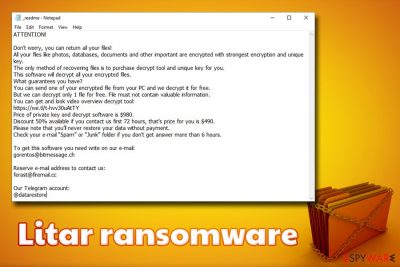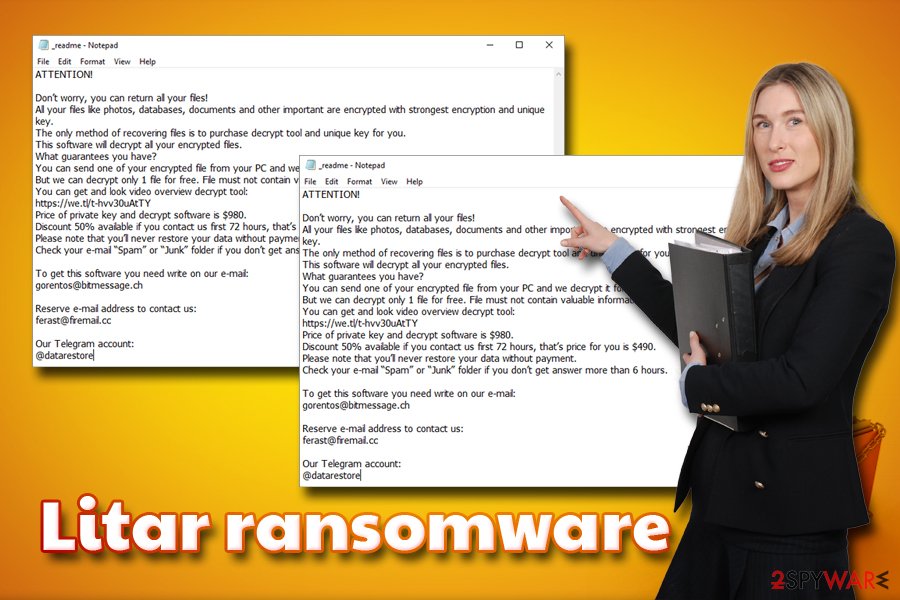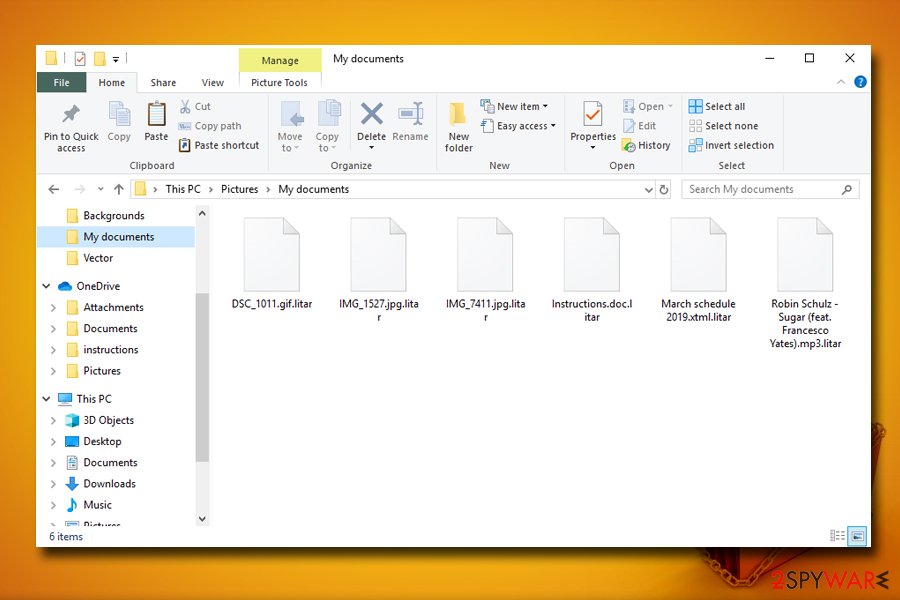Litar ransomware (Removal Instructions) - Recovery Instructions Included
Litar virus Removal Guide
What is Litar ransomware?
Litar ransomware is a file locking virus that belongs to the notorious malware family Djvu

Litar ransomware is a type of computer infection that focuses on money extortion by locking personal pictures, documents, databases, image, video, and other files. The encryption process is performed with the help of AES-256[1] or another strong encryption algorithm, and all files are appended with a .litar file extension, which prevents victims from using their data.
Litar ransomware was first spotted at the end of June, and it belongs to one of the most prevalent malware families around – STOP/Djvu. While email address and the appended extension vary, the goal of the string remains the same – to make users pay $980/$490 ransom in Bitcoin. Crooks ask victims to contact them via gornetos@bitmessage.ch, ferast@firemail.cc or @datarestore (Telegram) on a compiled ransom note _readme.txt, which is placed into each folder that contains compromised data.
While the decryption process might be complicated, many security vendors recognize[2] the threat as TR/AD.InstaBot.arm, Trojan-Ransom.Win32.Stop.ba, Trojan.MalPack.GS.Generic, etc., so Litar ransomware removal can be performed using anti-malware tools.
| Name | Litar |
| Type | Ransomware |
| Family | STOP/Djvu |
| Cipher | AES |
| Extension | .litar |
| Ransom note | _readme.txt |
| Related files | 8312fe0b372ea144637254f5c27fbcc0.virobj |
| Contact | gornetos@bitmessage.ch, ferast@firemail.cc, @datarestore (Telegram) |
| Decryptable? | Might be possible with the STOPdecrypter [download link] by Michael Gillespie |
| Termination | Use anti-malware software like FortectIntego, SpyHunter 5Combo Cleaner or Malwarebytes |
Litar ransomware authors use a variety of deceptive and sophisticated techniques to distribute the malicious payload in order to infect more users around the world, consequently maximizing the chance of ransom transfers. A few examples of the most popular methods include:
- Exploit kits
- Web injects
- Fake updates
- Software cracks
- Spam emails
- Brute-force attacks, etc.
To find how to avoid ransomware infections in the future, please refer to the second section of this article.
Once Litar virus enters the host computer, it performs several changes to it, such as modification of Windows registry, shadow volume copies removal, and others. These adjustments allow the malware to perform file encryption undisturbed. Additionally, some versions might even disable security software and install secondary payload like AZORult trojan.
After that, Litar ransomware encrypts all personal files on the hard drive, solid state drive, or any other connected storage devices. Users are unable to open any data, although the installed programs and system files that require Windows to operate are left untouched. The ransom note is dropped into every folder where locked data is located, and it states:
ATTENTION!
Don’t worry, you can return all your files!
All your files like photos, databases, documents and other important are encrypted with strongest encryption and unique key.
The only method of recovering files is to purchase decrypt tool and unique key for you.
This software will decrypt all your encrypted files.
What guarantees you have?
You can send one of your encrypted file from your PC and we decrypt it for free.
But we can decrypt only 1 file for free. File must not contain valuable information.
You can get and look video overview decrypt tool:
https://we.tl/t-hvv30uAtTY
Price of private key and decrypt software is $980.
Discount 50% available if you contact us first 72 hours, that’s price for you is $490.
Please note that you’ll never restore your data without payment.
Check your e-mail “Spam” or “Junk” folder if you don’t get answer more than 6 hours.To get this software you need write on our e-mail:
gorentos@bitmessage.chReserve e-mail address to contact us:
ferast@firemail.ccOur Telegram account:
@datarestore
Do not pay the ransom, as hackers behind Litar ransomware might simply take your money and never send the decryptor back. Besides, it would only encourage them to produce more viruses and infect more people around the world.

Therefore, rather remove Litar ransomware with adequate tools, such as FortectIntego or SpyHunter 5Combo Cleaner, although other security applications can be used as well. After that, you can try several file recovery methods if you do not have backups.
Ransomware avoidance recommendations
Ransomware is possibly one of the most devastating malware categories, as the ramifications of its presence are left behind even after its removal. While regular users can lose access to precious photos or valuable worksheets, companies might end up paying a much higher price – they spend millions of dollars for the recovery operations and IT infrastructure renewal.
While there are no malware prevention techniques that would protect you 100%, the reduction of the infection possibility can be reduced drastically, as long as you follow these simple recommendations from industry experts:[3]
- Do not use outdated operating systems like Windows 7 or XP – they are not safe;
- Update Windows as soon as patches are released, along with all the installed software;
- Beware of spam email attachments and hyperlinks – phishing emails are often used by criminals to inject malware into users' devices;
- Do not download pirated software and cracks/keygens;
- Install ad-blocker;
- Use strong passwords for all your accounts and enable two-factor authentication where possible;
- Make sure you keep comprehensive anti-malware software running at all times.
Get rid of Litar ransomware to have a chance at file recovery

Be aware that you need to remove Litar ransomware before attempting file recovery. As we previously mentioned, cryptoviruses lock the data on the host computer, as well as all connected storage devices. Thus, if you attempt to add any new files while the machine is still infected, you will lose them as well – including the backups. Therefore, make sure you enter Safe Mode with Networking and use anti-malware software for full Litar ransomware removal.
While there is no definite decryptor for Litar virus, you can try a decryption tool that was developed by an independent security researcher. In case the encryption process was performed offline, there is a good chance of recovering data for free. Alternatively, you can try third-party tools that might be able to retrieve at least some of your pictures, documents, videos, etc.
Getting rid of Litar virus. Follow these steps
Manual removal using Safe Mode
If your security application is being tampered with by Litar ransomware, enter Safe Mode with Networking:
Important! →
Manual removal guide might be too complicated for regular computer users. It requires advanced IT knowledge to be performed correctly (if vital system files are removed or damaged, it might result in full Windows compromise), and it also might take hours to complete. Therefore, we highly advise using the automatic method provided above instead.
Step 1. Access Safe Mode with Networking
Manual malware removal should be best performed in the Safe Mode environment.
Windows 7 / Vista / XP
- Click Start > Shutdown > Restart > OK.
- When your computer becomes active, start pressing F8 button (if that does not work, try F2, F12, Del, etc. – it all depends on your motherboard model) multiple times until you see the Advanced Boot Options window.
- Select Safe Mode with Networking from the list.

Windows 10 / Windows 8
- Right-click on Start button and select Settings.

- Scroll down to pick Update & Security.

- On the left side of the window, pick Recovery.
- Now scroll down to find Advanced Startup section.
- Click Restart now.

- Select Troubleshoot.

- Go to Advanced options.

- Select Startup Settings.

- Press Restart.
- Now press 5 or click 5) Enable Safe Mode with Networking.

Step 2. Shut down suspicious processes
Windows Task Manager is a useful tool that shows all the processes running in the background. If malware is running a process, you need to shut it down:
- Press Ctrl + Shift + Esc on your keyboard to open Windows Task Manager.
- Click on More details.

- Scroll down to Background processes section, and look for anything suspicious.
- Right-click and select Open file location.

- Go back to the process, right-click and pick End Task.

- Delete the contents of the malicious folder.
Step 3. Check program Startup
- Press Ctrl + Shift + Esc on your keyboard to open Windows Task Manager.
- Go to Startup tab.
- Right-click on the suspicious program and pick Disable.

Step 4. Delete virus files
Malware-related files can be found in various places within your computer. Here are instructions that could help you find them:
- Type in Disk Cleanup in Windows search and press Enter.

- Select the drive you want to clean (C: is your main drive by default and is likely to be the one that has malicious files in).
- Scroll through the Files to delete list and select the following:
Temporary Internet Files
Downloads
Recycle Bin
Temporary files - Pick Clean up system files.

- You can also look for other malicious files hidden in the following folders (type these entries in Windows Search and press Enter):
%AppData%
%LocalAppData%
%ProgramData%
%WinDir%
After you are finished, reboot the PC in normal mode.
Remove Litar using System Restore
You can also try System Restore for the malicious payload removal:
-
Step 1: Reboot your computer to Safe Mode with Command Prompt
Windows 7 / Vista / XP- Click Start → Shutdown → Restart → OK.
- When your computer becomes active, start pressing F8 multiple times until you see the Advanced Boot Options window.
-
Select Command Prompt from the list

Windows 10 / Windows 8- Press the Power button at the Windows login screen. Now press and hold Shift, which is on your keyboard, and click Restart..
- Now select Troubleshoot → Advanced options → Startup Settings and finally press Restart.
-
Once your computer becomes active, select Enable Safe Mode with Command Prompt in Startup Settings window.

-
Step 2: Restore your system files and settings
-
Once the Command Prompt window shows up, enter cd restore and click Enter.

-
Now type rstrui.exe and press Enter again..

-
When a new window shows up, click Next and select your restore point that is prior the infiltration of Litar. After doing that, click Next.


-
Now click Yes to start system restore.

-
Once the Command Prompt window shows up, enter cd restore and click Enter.
Bonus: Recover your data
Guide which is presented above is supposed to help you remove Litar from your computer. To recover your encrypted files, we recommend using a detailed guide prepared by 2-spyware.com security experts.If your files are encrypted by Litar, you can use several methods to restore them:
Data Recovery Pro option
Data Recovery Pro is initially designed to retrieve files that were accidentally deleted or otherwise damaged. Nevertheless, it sometimes helps ransomware victims as well.
- Download Data Recovery Pro;
- Follow the steps of Data Recovery Setup and install the program on your computer;
- Launch it and scan your computer for files encrypted by Litar ransomware;
- Restore them.
Make use of Windows Previous Versions feature
Windows Previous Versions feature would be a useful solution if you had System Restore enabled before ransomware attacked your PC. Nevertheless, be aware that this method allows you to recover files one-by-one, so processing a large amount of data might be overwhelming.
- Find an encrypted file you need to restore and right-click on it;
- Select “Properties” and go to “Previous versions” tab;
- Here, check each of available copies of the file in “Folder versions”. You should select the version you want to recover and click “Restore”.
In some cases, SahdwoExplorer will help you
If you were lucky and Litar ransomware failed to delete Shadow Volume Copies, ShadowExplorer is the tool to try:
- Download Shadow Explorer (http://shadowexplorer.com/);
- Follow a Shadow Explorer Setup Wizard and install this application on your computer;
- Launch the program and go through the drop down menu on the top left corner to select the disk of your encrypted data. Check what folders are there;
- Right-click on the folder you want to restore and select “Export”. You can also select where you want it to be stored.
Try STOPDecrypter
The STOPdecrypter [download link] will only work if the encryption process was performed when your machine was not connected to the internet or if the virus failed to contact C&C server for some other reason.
Finally, you should always think about the protection of crypto-ransomwares. In order to protect your computer from Litar and other ransomwares, use a reputable anti-spyware, such as FortectIntego, SpyHunter 5Combo Cleaner or Malwarebytes
How to prevent from getting ransomware
Do not let government spy on you
The government has many issues in regards to tracking users' data and spying on citizens, so you should take this into consideration and learn more about shady information gathering practices. Avoid any unwanted government tracking or spying by going totally anonymous on the internet.
You can choose a different location when you go online and access any material you want without particular content restrictions. You can easily enjoy internet connection without any risks of being hacked by using Private Internet Access VPN.
Control the information that can be accessed by government any other unwanted party and surf online without being spied on. Even if you are not involved in illegal activities or trust your selection of services, platforms, be suspicious for your own security and take precautionary measures by using the VPN service.
Backup files for the later use, in case of the malware attack
Computer users can suffer from data losses due to cyber infections or their own faulty doings. Ransomware can encrypt and hold files hostage, while unforeseen power cuts might cause a loss of important documents. If you have proper up-to-date backups, you can easily recover after such an incident and get back to work. It is also equally important to update backups on a regular basis so that the newest information remains intact – you can set this process to be performed automatically.
When you have the previous version of every important document or project you can avoid frustration and breakdowns. It comes in handy when malware strikes out of nowhere. Use Data Recovery Pro for the data restoration process.
- ^ Margaret Rouse. Advanced Encryption Standard (AES). SearchSecurity. Information Security information, news and tips.
- ^ 333de00da48f4c3020580aa11633c7b026d2277254130332982c1db5656816da. Virus Total. File and URL analyzer.
- ^ Virusi. Virusi. Cybersecurity expert advice.





















